#these screenshots were all taken before I install Island Living
Explore tagged Tumblr posts
Photo



Lauela Living- Prologue
Willow Creek Complex 4:21 pm
#ts4#sims 4#ts4 island living#sims 4 island living#ts4 gameplay#Lauela Living#prologue#Traci Danielson#Tyler Danielson#Maria Avalos#Stacy King#these screenshots were all taken before I install Island Living#but that doesn't matter#this is a prologue
14 notes
·
View notes
Text
Reading Response 1 - Postmodernism
Postmodernism is a art category full of variety. Through it’s ability to expand to multiple mediums that can reach a wider range of people all of the world. Whether it sits in a park or is on someone’s t-shirt, this ability allows more people to see it than those who can only see certain art by visiting a specific museum. Escaping the Confines of Museums: The best example of this is art installations in public places. Allowing for the artist to move the piece to widen the audience it can reach overall. Jenny Holzer is a good example of art that is mobile while still having a great impact. With her series VIGIL she shares the stories of those affected by the reality of gun violence. With their words displayed brightly on the sides of buildings, their stories are reaching further and effecting more people all over these cities.

‘VIGIL’ Project Projection on Building Jenny Holzer October 2019 Collapsing Boundaries Between “High” and “Low”: Postmodern art allows for artists to break boundaries that modernist artists put in place to separate their “high art” with things experienced in ‘ordinary life’. Postmodern artists push to break this narrative by including everyday things in their art that allow their art to appeal to a wider range of audiences, whether they are from this “high art” culture or the lower culture. Jeff Koons is a great artist that goes against the “high art” culture with him installation pieces that are often very common/well known objects that he makes in a larger scale. Such as his piece ‘Play-Doh’ which is a very well known child’s craft item that most people can recognize with ease.

Play-Doh Installation Jeff Koons 1994-2014 Rejecting Originality: Since their is a high value for art to be very original in the eyes of modernists, postmodernists challenge this by questioning the concept of originality in these times. The idea of making a completely original piece is a difficult feat. Since a majority of ideas have been explored in some sense even if you’ve never personally seen it. With a postmodern approach art in a much more liberating way that pulls themes from other sources before adding their own spin. Artists like Damien Hirst uses animals suspended to push a new narrative and allow for an interesting up close and personal perspective that many would never see in their life. Making his pieces simple but very unique.

The Physical Impossibility of Death in the Mind of Someone Living Glass, painted steel, silicone, monofilament, shark and formaldehyde solution Damien Hirst 1991 Jouissance: Acting as the postmodern aesthetic experience, joussiance allows the viewer to become lost in a piece through the pleasure derived from viewing it. Compared to the modernist experience which is done at a distance, postmodernists allow for a very personal experience.
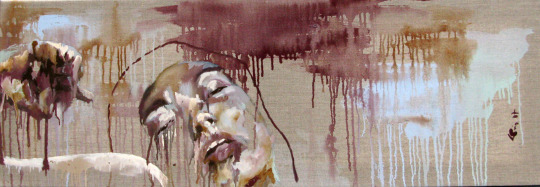
Jouissance Painting on canvas on stretcher Damien Legrain 2019 Working Collaboratively: Compared to modern times, where individual contributions are a lot more valued, in a postmodern environment there is a lot more collaboration in many art pieces. There is now the ability for several artist to contribute to a piece from all over the world, adding many more cultures and interesting perspectives in postmodernist art. In the example I put, the piece is a large collaborative piece consisting of 22 separate layers that come together into one piece. Each layer being made by a different artist.
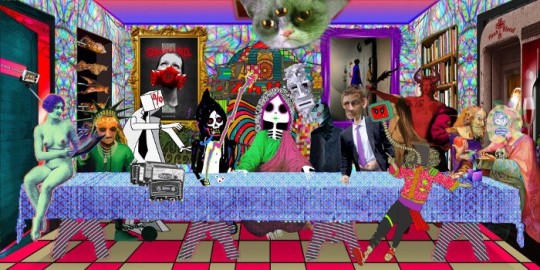
First Supper Collaborative Piece (22 layers) Artists Include: Alotta Money, Blackboxdotart, Coldie, Connie Digital, Hackatao, Josie Bellini, Matt Kane, Mlibty, Rutger van der Tas, Shortcut, TwistedVacancy, VansDesign, and XCOPY 2020 Appropriating: This approach is the exact opposite of the modernist views of originality through the use of imagery that already exists. Whether that media be from other artists or generalized imagery (like from the grocery store). Appropriating is a form of manipulation of the previously stated media, and is able to shift and make a new message through borrowed images. The example put is from Richard Prince and his exhibition called Portraits. Where Prince uses Instagram selfies for his own artistic message.

Portraits Photography/Screenshots Richard Prince 2014 Simulating: Simulation art is an imitation/copy of other pieces. Simulacra are copies of things that no longer have an existing original, or perhaps they never had one at all. Another example simulacra is when a cartoon/representation lasts longer than the real person they were based on. Like Betty Boop or Helene Stanley who was the live action model for both Cinderella and Sleeping Beauty from Walt Disney’s famous animated movies. The example put is a photograph taken by Jean Baudrillard who is a prominent figure in the postmodern would in simulacra.

Saint Clément Giclée print on pure cotton paper Jean Baudrillard 1987 Hybridizing: This postmodern art form is a way to mix various diverse cultural influences in a single piece. These pieces can pull from cultures that the artist is part of personally, or maybe just parts of separate cultures that interest them. Examples of these were western style art mixing with non-western style art. The posted example picture is from Masami Teraoka, who pulls themes from Western and Eastern cultures to make traditional Japanese art prints and adds his own western spin to that Japanese theme.

Hawaii Snorkel Series/Longing Samurai Twenty-four-color woodcut, etching, and aquatint printed from one copper plate and eleven woodblocks on natural Fuji paper Masami Teraoka 1993
Mixing Media: Mixing media is just that, mixing media! The postmodernists like to explore the limits of a media and how they can mesh with other medias to enhance their piece. Even just small mixing like adding glitter to a piece can change the meaning to an art. The piece show is from the artist Robert Rauschenberg who combines many different mediums on paper and sculpture to make dynamic and interesting pieces.
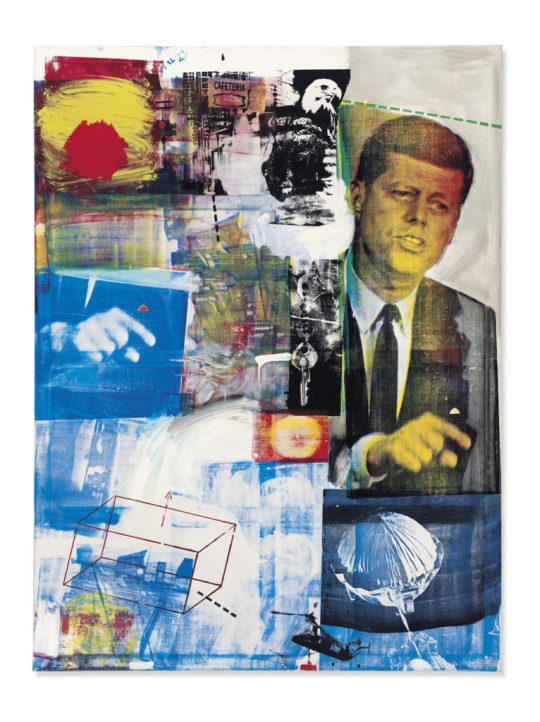
Buffalo II Silkscreen Robert Rauschenberg 1964
Layering: Layering is an art form that many artists can preform due to it being inexpensive to mass produce pictures and nowadays there is a lot of images and media available to use without too many issues. The artist shown below is Gabby Frank, who made a piece that is a excellent example of a postmoderist collage. Layer images on newsprint/some sort of print piece.

Postmodern Collage Paper media Gabby Frank (Date not listed) Mixing Codes: The code being refers to the postmodern approach of mixing societal codes and using those codes to push an alternative narrative. Whether the codes be cultural, or commonly agreed upon. The example shown is from the artist Michael Ray Charles who uses the code mixing to show the viewers the racial biases they may have. Which is an excellent example of the mixing to show an alternative view/narrative.
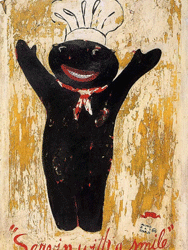
(Forever Free) ‘Servin with a smile’ Paint on canvas Michael Ray Charles 1994
Recontextualizing: Through the use of previously familiar images, recontextualizing in the postmodern view is a way to change the meaning of the imaging being borrowed through repositioning and the use of addition/added on media to give the pieces a new meaning and significance. Fred Wilson is considered a master of recontextualization and his work is an interesting look into his views on the world.
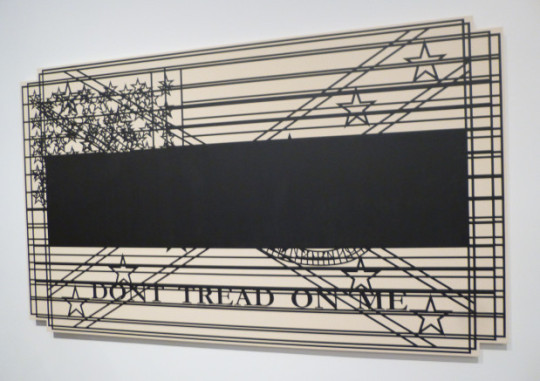
Don’t Painted wood Fred Wilson 2010
Confronting the Gaze:
Confronting the gaze originally refers to the identification of the ‘male gaze’ which a lot of media is made around. Many works of western historical art that depict women are a result of the male desire to stare at and sexualize women. Worse than that, there was some blame from these men towards the women that were the subject. Since then, there has been some artists and pieces that have begun exploring the ‘female gaze’ and used their art to depict what females may actively desire. Tracy Emin is an example of the artists who explore the female gaze and has made many pieces in her simple style, a lot of which follow a similar romantic or sexual narrative.

The Kiss Polymer gravure printed in blue Tracey Emin 2011 Facing the Abject: The abject in question is referring to the less than lovely aspects of life. Especially things that involve bodily functions. It also involves things like the hatred of food, trash, waste, even animal dung. Facing the abject in art is usually letting piece involve things that are usually considered on the ‘ugly’ side. Kiki Smith, the artist whose piece is featured is something that shows the original abject towards bodily functions. Pushing for people to accept the reality of bodily functions.
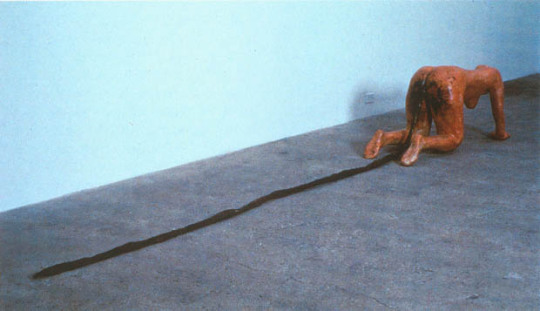
Tale Fiber glass, wax, mix media Kiki Smith 1992 Constructing Identities: People tend to form opinions on those around them based on how they may look, or even surface level information that they may have on them. Due to their own personal ideas on things like race, gender, sexual orientation, etc. Since people tend to have a certain opinion/ideas on people based on these things, whether they mean to or not. Gran Fury was a group of activists that teamed up with ACT UP another group to bring awareness to the problems in the LGBT community and the AIDS pandemic. The piece show below is one of the graphics created in response to this lack of awareness towards AIDS.

Silence = Death Graphic Gran Fury 1988
Using Narratives: Telling stories is something people have been doing through all of history. Historical works of art often depicts stories whether they be biblical or otherwise. Many pieces of art, even now, have a story to tell their audience. Especially things like modern movies, cartoons, and books. They all usually aim to tell a story to entertain an audience. Artists like Eric Fischl uses his paintings to tell pieces of stories. Like the piece shown below.

A Visit To/ A Visit From/ The Island Oil on canvas Eric Fischl 1983 Creating Metaphors: To attribute the qualities of something to something else is to create a metaphor. Generally all images can be considered metaphors in some sense, although some postmodern artists work to make imagery of a particular narrative. Such as Chuck Close, who has a self portrait of himself which can act as a persona that the artist is wanting the audience to see of him.

Self-Portrait Screenprint Silkscreen Chuck Close 2012
Irony, Parody, and Dissonance: All three of these are intertwined with each other in life. Artists are using these three themes/ideas to provoke a new questioning of the viewers previous knowledge. Sometimes these can fall short in the grand scheme of things and be taking literally. Resulting in a great misunderstanding and cause issues for the those involved. To understand the impacts and purpose intended behind the work, it is important for the viewer to understand the original unironic content that has been shifted an challenged. James Luna is an artist who uses irony,parody, and dissonance to convey his political views as a half Mexican, half Indian man.
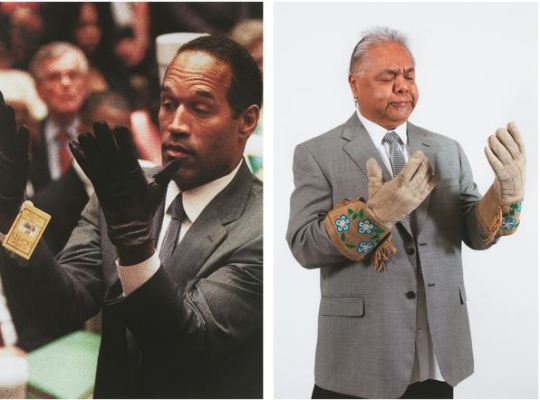
Trial and Error Photography Print James Luna 2011 -----------------------------------------------------------------------------------------------------------
5280 - 3 Mixed Media Artists Reading Response:
This article is honestly wonderful to look at to explore the processes of artists from Colorado, one of which going to the same school as me! It overall makes me hopefully for what my future has in-store and my hope to one day find where I belong in the artist community.-Tya Alisa Anthony’s collage was dynamic and interesting. Allowing for an interesting perspective into BIPOC stories and their history. Adding color to the piece through the shorts allows for a pull back to modern times and how their are still stories that need to be told!-Mario Zoots was the artist I was the most interested in from hearing that he went to MSU Denver. I like the collage he made, it feels like something one would make in a journal of their travels. It also made me feel like I may have stumbled upon the journal in the woods, adding an eerie feeling to what’s on the page. That is such an interesting dynamic to encounter!-Kelly Duffield’s pieces are overall the most interesting for me to look at. Since the previous two were a lot different in theme and the overall feel they gave off a bit more of a mature feeling. Duffield’s work really tips into a feeling that I would describe as “a weird dream I once had”. The piece is definitely one that can be interpreted in many different ways by different people and that value in a piece is something that can be hard to achieve. Overall these three artists are great at what they do and I hope to see more of their work in the future!
5 notes
·
View notes
Text
Questions Tags
I was tagged in a number of those recently. And because I got behind and they were piling up, I decided to have my pick and answer those I felt I had something to say on.
Questions from @declarations-of-drama , @simcatcher , @sillylittlesimblr , @jepensedoncjesims , @trembling-hands , @mada-didi
Declarations-of-Drama’s questions
1. The boss of EA is in front of you asking for one statement about The Sims before he goes away and makes TS5. What do you say to him?
Ask @simcatcher about her ideal Sims game and do exactly as she says. (She suggested a Sims game with passing eras, and really I think that should be doable. Sim City 2000 was a bit like that - you could choose to start 1900, 1950 or 2000, and development would take place accordingly.)
2. Do your Sims know of you as their Sim God or are you the invisible deity to them?
More like the invisible deity, but I wouldn’t call it that. I see my Sims like fictional characters in writing or in a play. Even if the author is of course in charge of their fate, this doesn’t affect religiosity within the work of fiction. And even more abstract, those Sims in heavily scripted and posed stories I see as fictional actors playing the actual characters (not unlike the production of MKASONP ;) To those I’m the director, which makes it a lot easier to keep the right emotional distance for storytelling.
3. How do you see yourself connected to your Sims? Do those of you who say you love them, really mean this? How deep is your game?
I’m definitely feeling responsible and sometimes even overprotective about my Sims. Partly because that’s just my personality, partly because I started playing Sims 1 as a kid and there it was not so easy to keep a Sim alive and happy. And the way I understood games at the time, Sims dying meant: You lost!
Nevertheless, I’ve finally gotten rid of the habit to start every new household with making all Sims learn cooking in order to avoid fires.
4. What’s your Sims Secret? Is there something going on in your game that none of your screenshots will ever tell us? WHO IS LOCKED IN YOUR BASEMENT???? What are those secret Sims doing behind closed doors?
Nothing major. The weird stuff that happens is usually so funny that I post about it anyway.
5. Can we learn anything from our Sims to take away into our real lives? And/Or can you give us an example of how The Sims has influenced you outside of gaming.
When I finished highschool, I was really nervous about going to university, and playing the Sims 2 University EP was strangely therapeutic in this situation.
Simcatcher’s questions
1) What’s your favorite story/tale/scenario playing over and over in your head ? Gimme a glimpse ?
It used to be the central scenes of Chevalry, but not so much any more since I got them out of my system. It still feels so weird to think of this as a finished story.
2) What’s the screenshot/edited pic of yours that you’re the most proud of ? Can I see ?
There are so many screenshots I love... Here’s one of which I’m particularly proud of the editing:

3) I would want to read an unedited bit of your writing. Something you did, something personal or neutral, something that feels important. Cos it probably is. You can use your joker on this question. Or share your talent ♥
Most of my unedited stuff is German, so this is really random: It’s a fragment of a shortstory I never got to work properly. It’s supposed to be about a girl who’s haunted by a story. It’s a fairytale-ish story of love and adventure and she’s just waking up to the realization she’ll have no chance of this in her own life. She tries to avoid hearing how it ends, but wherever she goes she stumbles upon snippets of it. I wrote this in English because I meant to hand it in for the University’s English magazine.
The only way to flee from the story was down the stairs. My bare feet were freezing cold when I entered the kitchen. I could still hear a mutter from upstairs, but there was no other room I could go to. For the first time I realized how small our house was. I sat down on a kitchen-chair and sang to myself under my breath to keep me from listening. That's how Mama found me. “Hey, what was the matter with you just now? It's such a nice story.��
“I didn't like it.,” I told her curtly and hurried back upstairs. The story had unsettled me. My hands were shaking when I opened our bedroom-door.
“[...]”, Caroline beamed at me, when I entered. “[...]”
“Shut up!”
Luckily Caroline is easy to impress. She threw her blanket over her head and didn't say another word.
I went to sleep, I got up the next morning, I went to school. I was sitting at my desk sleepily. I had been dreaming of running away all night, but the faster I ran, the more clearly I heard the words I so dreaded. I wasn't paying any attention, so I was rather surprised, when my neighbour handed me a worksheet. “Read the following extract:,” it said. [And it’s an extract of The Story, of course]
4) What do you get inspiration from ?
Everything. History, houses I see in town, places I’ve been to, songs and misunderstood lyrics, listening to music on the train. Stories that I like, or dislike, or like parts of, or when reading a lame story and imagining it was a good one.
5) Do you sometimes want to create a sim story out of a dream you had ?
Not exactly a Sim story, but I have a collections of dreams written down that I’d love to make into stories. Unfortunately, they’re all completely crazy and surreal.
7) If you’re a writer/storyteller, what’s your working pattern ? What’s your routine, if you have one ? How do you write ?
I think the most work I’m doing when I’m walking somewhere or doing boring work. Especially since I started writing in dialogues, I practically know the scenes by heart and can fine-tune them wherever I am. It’s just important to write them down when I get back to my computer.
8) Which sim of yours do you like the most ? Why ? Feel free to tell me more infos about them, what’s their sign, religion, beliefs, what do you think is relevant ?
I’m finding it increasingly difficult to distinguish between Sims and Characters...
9) What is your favorite sim couple ? Yours or other simblr’s ? Why ? What specifically makes you want to see them together ? Becaaaaaause will not be taken as an answer*
I’m all for including @jepensedoncjesims ‘ Mazen and Ara Frost in the Ultimate List of Most Romantic Couples Ever. Y’know because they literally waited an eternity for each other, and lost themselves in the process beyond recognition and still there are sparks between them. And also they’re both very good-looking! And I’m so curious about how things are with their daughter!
10) Do you have a story you wrote/write/want to write that you want to tell me about ? I sure would want a link :)
There used to be one on the internet, I wrote for the above mentioned magazine, but it’s down...
Jepensedoncejesims’ Questions
2. What do you look forward to the most, as you wait for your game to load?
That depends on which save I’m loading, but the most exciting is when I’m testing some self-made item for the first time and can’t really tell if it’s going to work as I imagined.
It has actually happened that when loading a playing save without special purpose, I found the book I was reading in the meantime more interesting...
3. When is the last time you went in game AND what did you get up to?
The last time I opened The Sims 3 was when I did the What’s-in-my-Sim’s-bag photoshoots, and the very last time was when I drafting the posts and suddenly realized that Edward and Arthur should change bags. ETA: And by now I also did a story-scene.
5. If you decide to actually do this…why are you even answering my questions?
Because I love question 2!
Sillylittlesimblr's questions
1. Why did you create a simblr?
I discovered simblr through cc-hunting, and then I saw that one could also post gameplay pictures there. I was just at the beginning of learning to make cc myself and this community felt like something I wanted to join (and that’s a rare feeling with me!)
3. When did you start playing the sims & which game (1 - 4) was it?
A friend from school showed me the Sims 1 on her computer when I was eleven, and I instantly loved it. I was super shy about asking my parents if I could have the game for Christmas - it was so grown-up! I had only played interactive learning games before. I got it though, and that's the reason why the ts1 buymode tune still puts me in a Christmas mood when I hear it.
4. Who is your favourite sim you have ever created?
Valea. She's perfect.

6. Mermaids or fairies?
Mermaids! Fairies! Fairies!! Mermaids!!

7. What’s the weirdest thing that has happened naturally in-game?
Admittedly, this was mod-generated in its cause: The fist time I played a male pregnancy in Sims 3 I didn't know I’d need to install special clothing. So the poor guy became invisible from the neck down. Well, he lived as a floating head until the baby was due and then he floated off to hospital. Ten seconds later his sister, who lived in the same household and worked as a nurse, was called to hospital. They said, an emergency had just arrived...
8. Big pets (cat, dog, horse) or small pets (turtle, bird, etc)
Big pets. I always lose small ones - either in Sims' inventories, or through death or during household rotation.
9. What’s your favourite build you have ever done OR EA made build?
My favourite self-made build is Broadbent Manor. For once this turned out to have realist proportions and be playable, and look decorative.

10. What’s your favourite EA made neighborhood (can include the vacation ones too!)?
Dragon Valley! It's beautiful and it has so many interesting Sims in it.
Teltaodstool's questions
1. How many screenshots do you have?
Ah well, I'm a historian. I like archives. Windows says it's 19.596 files in 179 folders. That's not counting technical screenshots for cc; those are stored with the respective project. I actually deleted a bunch of those recently.
4. I know this is asked a lot, but which expansion did you get first?
Pets. Actually I bought Sims 1, 2 and 3 only after the Pets EPs came out, so I could get those right after the basegame. (When I started playing the Sims, one of my biggest wishes was to have a pet in real life)
5. Do you remember who your first sims were?
I have a visual memory of my first (or at least a very early) Sims 1 family. It was a single mother with her daughter (I wasn't good enough at the game to manage more than two Sims). I don't remember what they were called, but I think the daughter's name might have been 'Kiera'.
6. Have you ever accidentally killed a sim?
Yes, that happened once in Sims 1. More recently, my Cave Island Legacy founder was accidentally killed by the game (meteor), but I decided to turn it into a close call for the story's sake.
The classic thing of walking away without pausing happened to me once in the Sims 2. All my Sims survived, but served a large number of stuffed turkeys :D
7. How many sims are in your household usually?
2-6. One sim alone makes me claustrophobic (and causes the game to glitch), and with more than 6 Sims it gets stressful. That's for gameplay though - for storytelling, 8 Sims is a small household.
8. Have you ever tried to make a custom world? Whether by the Create a World tool or in a save, it doesn’t matter.
Well, making Bakafox's Howell Island DIY into my Maplethorpe Save counts, I guess :) Sometimes I work on a custom edit of the France WA world to resemble ts2 Veronaville, but I haven't touched it recently.
9. What’s the weirdest thing you’ve seen the Grim Reaper do?
In my own game: Playing with the little chickens. But the weirdest Reaper scene I've ever seen was on someone else's blog shortly after ts4 came out and there was that glitch that made Grim appear all over town. He came to a party and felt a pregnant woman's belly. (Sorry, I don't remember who posted that!)
Mada-didi's questions
2. What type of simmer do you consider yourself to be? Storyteller, builder, casual player, simsphotograph, all of them, none of them or other?
Storyteller. Even when I'm just playing.
3. Can you choose a near-future objective for you to accomplish as a Simmer? (Example: for me, it would be to finish the first generation of Ostracizing Humanity.)
I'm super excited for the Cave Legacy finale. But I'm going to take a short break from it first.
5. Imagine you have no responsibilities. Would you rather play the Sims a little everyday or spend two days a week playing as much as you want?
I'd rather have some responsibilities during which I can find new inspiration for (sim-)stories :)
6. In your opinion, what Sim resembles you the most personality-wise? (It can be created by anybody, may it be EA, you or another player.)
Marie-Constance by @aroundthesims - always completely frightened, especially in public and most particularly at parties.
20 notes
·
View notes
Text
Hyperallergic: Measuring the Social Impact of Internet Images
Sheila Pree Bright, “#1960Now: Art + Intersection” (2015), video still (© Sheila Pree Bright)
Perpetual Revolution: The Image and Social Change, a complicated, dense, and ambitious exhibition at the International Center of Photography (ICP), endeavors to tackle the relationship between new media and the currents of contemporary social change. This theme is vast, encompassing information, misinformation, propaganda, self-expression, social justice movements, news, and autobiography — all expressed through online images. A central question emerges from such a grand scope: is there wisdom to be gained by taking pieces of the internet and showing them in a white cube?
Perpetual Revolution is, wisely, separated into six thematic sections: “Climate Changes,” “The Flood: Refugees and Representation,” “The Fluidity of Gender,” “Black Lives (Have Always) Mattered,” “Propaganda and the Islamic State,” and “The Right-Wing Fringe and the 2016 Election.” This breakdown enables easier digestion of the show’s smorgasbord. The viewer must trust that each section’s curators have chosen content that’s particularly representative or revealing of its stated theme, as the act of paring down the vast trove of images on the internet is nearly incomprehensible. Our heightened awareness of the curators’ subjectivity requires us to take a larger-than-average leap of faith in regards to their wisdom.
Installation view, Perpetual Revolution: The Image and Social Change at the International Center of Photography (photo by Saul Metnick for ICP)
We often see an art exhibition space as purposely blank for both aesthetic and political reasons. This expectation becomes an interesting problem when the space is being used to show sinister propaganda, photojournalism created to document the plight of others, and art side by side: how can visuals with such disparate aims be displayed together in a space with conflation? The IS and US right wing sections of Perpetual Revolution ask viewers to examine evidence of violent ideology. The former, curated by Carol Squiers with assistance from Akshay Bhoan, shows videos meant to lure recruits and present a favorable view of life in the Islamic State, including music videos and IS members distributing school supplies to children; it also contains snippets of more brutal propaganda, including Jihadi John threatening hostages. Similarly, the US right-wing fringe gallery, curated by Susan Carlson and Claartje van Dijk, contains disturbing white nationalist images, including many posted on social media by our current President. One of the most extreme visuals, from 2016, displays Pepe the Frog dressed as a Nazi and gassing an anti-Semitic caricature.
ISIS distributes school supplies to girls in Mosul, Iraq (2015), video still
Pepe with swastikas in his eyes (c. 2016), screenshot
I question how much much intellectual validity there is to the examination of these images in an exhibition space, and within the context of a show that includes art. The wall text for the IS section notes: “This gallery has been conceived as a study center rather than a traditional exhibition … In the case of overt propaganda, knowledge is necessary to successfully withstand and combat its appeal.” But the danger of so much propaganda is that it subsumes knowledge to aesthetics in the service of violent political ideals. Of course, showing such material in a museum setting is hardly radical; the plethora of exhibitions about Soviet films, posters, and design comes to mind. In the case of those, however, their visual interest and general lack of violence support their display in an aesthetic context. When it comes to Islamic State and neo-Nazi propaganda, can the violence of the imagery and the real-time violence we know these groups are justifying and enacting be truly offset by an intellectual inquiry? I’m not sure of the answers, but I think these questions deserve a fuller examination, one that Perpetual Revolution does not undertake. Perhaps the IS section would have been more successful with more didactics, the exclusion of the Jihadi John video, and a very careful focus on the ways in which IS uses aesthetic tools to recruit.
In “The Flood,” Tomas van Houtryve’s “Traces of Exile” (2016) plots the places that refugees today leave, pass through, and settle in using a large video map. Instagram posts by refugees appear on the map in their corresponding geographic locations, alternately showing the difficulties and normalcy of refugee life, and also creating a compelling visual of the vast distances they’ve traveled. “Traces of Exile” is far removed from photoreportage. But other works in this section are pure photojournalism, taken, for example, for the New York Times. When placed next to work that possesses a strong conceptual grounding or the firsthand accounts of refugees themselves, the photojournalism risks aestheticizing suffering. I commend ICP curator Joanna Lehan for exploring these boundaries; such questions of context, and by extension perhaps some of the failures of Perpetual Revolution, leave welcome room for complex thought about the lines between new media and art.
Sergey Ponomarev, Refugees arrive by a Turkish boat near the village of Skala, on the Greek Island of Lesbos (November 16, 2015), digital image, 9 monitors (original photograph © Sergey Ponomarev for the New York Times; photo by Saul Metnick for ICP)
The sections on climate change and Black Lives Matter operate in thematically similar ways: they show activist movements harnessing the power of new media platforms. I’m comfortable drawing a distinction between activism and propaganda — the former operates in the service of social justice and peace, the latter in service of destruction, repression, and violence. Works in these sections, curated by Cynthia Young and Kalia Brooks, respectively, demonstrate how artistic images and visual stories might elicit an emotional response from the viewer that, in turn, raises awareness of a specific political issue. One of the most beautiful works in the exhibition is James Balog’s video clip of the calving of the Illulissat Galcier in western Greenland in 2008, from the documentary Chasing Ice (2012). The video shows the majestic, forceful, and terrifying power of a huge piece of ice breaking away from a glacier; in the context of climate change, the fierce beauty of this occurrence is also a reminder of the scale of destruction that humans have unleashed. Sheila Pree Bright’s “#1960Now” (2017) employs intergenerational imagery of black leaders and activists to suggest that the struggle for equality and civil rights is cyclical and long. Nearby, an incredible wall of photography from ICP’s collection echoes this sentiment by presenting a range of ways in which images have captured black activism and life from the 19th century onward.
youtube
“The Fluidity of Gender,” curated by Squiers and Quito Ziegler, is the most successful section of Perpetual Revolution. Many of the images here were made to be aesthetically interesting and a means of self-expression — the work is, in a basic sense, creative. While certainly not all of it is joyous (nor should it be, given the oppression trans people continue to face), two contributions are memorably euphoric: one by AB Soto that’s titled “Cha Cha Bitch” and features the singer mixing stereotypically masculine and feminine dress, dance moves, and facial expressions; and a video series by French choreographer Yanis Mitchell that shows male dancers performing in heels to songs by Beyoncé, the Spice Girls, and Lady Gaga, among others. (The old saying is that Ginger Rogers did everything Fred Astaire did, except backwards and in high heels.) Watching Mitchell, I realized that men dancing in heels are sexy, and that so much of what’s deemed “feminine” is so performative, it can be almost instantly uncoupled from biological sex.
The content in the gender section shows that the internet is not only a space for authentic and/or performative self-expression, but that the joy that emerges from this freedom is deeply affecting, both personally and politically. This is social media at its potential best. Viewing this work near the Islamic State and right-wing fringe sections, it’s hard not to see the rise of nationalist and religious extremism as a direct reaction to a world that’s increasingly open to the liberation that exists outside of the binary.
youtube
The title of the show, Perpetual Revolution, suggests the Marxist theme of “permanent revolution,” which is neither a simple theory nor an easy thematic jump to new media. Broadly, Karl Marx used the phrase to suggest an ongoing attitude and political position that the proletariat should adopt to ensure that revolution was not halted prematurely, as conditions improved for the working class and the petite bourgeois achieved some gains. Trotsky used the phrase to suggest that not all countries would be able to, or should, pass through a phase of bourgeois, democratic revolution before enacting a socialist one. Therefore, he argued, the working class should lead the socialist revolution without waiting; this insurrection would be aided and sustained if it occurred in multiple countries.
One might draw the conclusion that the observable “perpetual revolution” online is both a genuine expression of social movements and a separate phenomenon that suggests more freedom than exists offline. The problem with the internet is that it can obscure the failings of neoliberal economic systems and the continued oppression of marginalized groups. In contrast to the Marxist idea of a continuous march of progress, the exhibition reminds us that the internet can function as a tool for evil and as a bit of a mirage — expression, activism, and propaganda online may not correspond in magnitude to what’s happening in the “real” world, particularly in the arenas of positive change, including the expansion of civil rights. Online activism and expression do not necessarily mean that laws have become more just, police practices less brutal, and rights for transgender people more protected. We’d be wise to remember that perpetual revolution is easier online than off.
Installation view, Perpetual Revolution: The Image and Social Change at the International Center of Photography (photo by Saul Metnick for ICP)
Perpetual Revolution: The Image and Social Change continues at the ICP Museum (250 Bowery, Lower East Side, Manhattan) through May 7.
The post Measuring the Social Impact of Internet Images appeared first on Hyperallergic.
from Hyperallergic http://ift.tt/2nOQSyU via IFTTT
0 notes